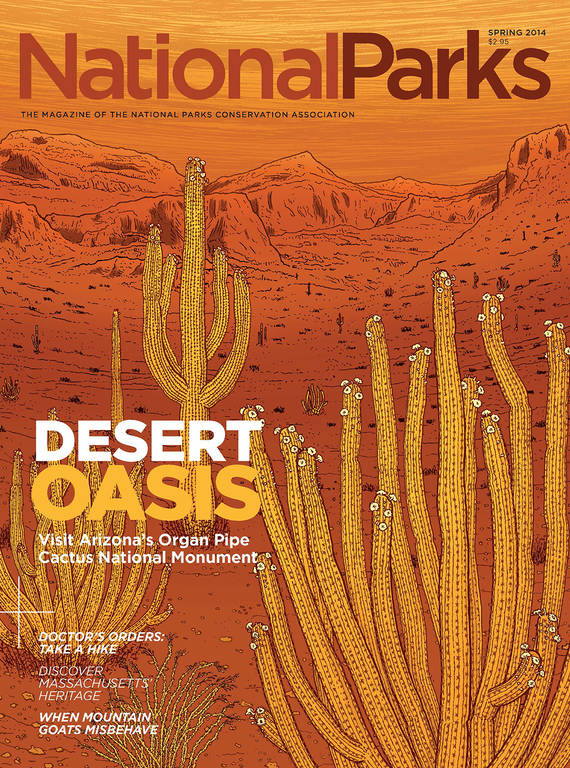Spring 2014
Getting Her Goat
Mountain goats have become an iconic part of the picture-perfect scenery of Olympic National Park, but when they get too friendly, someone has to take action.
I awoke to heavy, huffing breaths rippling the thin walls of my tent. My arms were pinned in my sleeping bag. My heart was pounding. I froze in place, listening to the sounds of some large thing investigating my camp, inches from my head. Dawn was hours away from the high country of Olympic National Park, and I was alone, warm, and comfortable in my bag—but the job had to be done. So I fumbled for my boots and headlamp, grabbed the paintball gun, and crawled out of the tent into the cold mountain morning. Poking my head out while on all fours, I came nose-to-nose with a 150-pound mountain goat, ghostly white in the starlight. She greeted me with a stare while I stumbled upright, gathered my breath, and shouted blearily the first thing that came to mind: “HEY! GOAT! LEAVE!”
She took about two steps sideways, then lowered her nose and resumed pawing at the dirt. Not impressed. I waved my arms, clapped, stomped, and shouted, “GO AWAY, GOAT!” Campers in adjacent sites stirred, confused and alarmed to be woken up in pitch darkness by shouts, but still the goat held her ground. “Okay,” I muttered, “if that’s how you want to play it….” I raised the paintball gun to my shoulder, set her in its sights, and fired at her rump. Two acid orange splotches bloomed on her white hide, and she took off, careening down the trail, galloping around tents, and circling back around trees, while I followed, yelling and pegging her with what rocks I could collect. She ran through each and every tent site before she finally gave up and galloped out of camp, straight up a steep hillside without seeming to slow down at all. I chased her until my legs gave out, which wasn’t very far; unlike a mountain goat, this human can’t sprint up a cliff. Wheezing, I ground to a halt. The goat turned, looked down on me, and dismissively kicked a basketball-sized rock at my head before bounding away into the darkness.
AN INVASIVE SPECIES
As I walked back to camp, I met a bewildered couple blinking outside of their tent. “What was that?”
Given the running start, I had neglected to put on the familiar green-and-gray uniform—in fact, I was in long johns with badly disheveled hair—so I explained that, despite present appearances, I was a biological sciences technician employed by the National Park Service to monitor and manage mountain goats in the Olympic high country.
A pause. Suspiciously: “What’s with the gun?”
“It’s a paintball rifle,” I replied, hoping to sound well-hinged and official. “We use it as a management tool to mark individual goats so we can monitor their behavior. It also packs a little punch to discourage them from approaching humans. They have thick hides so it doesn’t hurt them, but it doesn’t feel great either.”
A longer pause. “You get paid for this?”
THE SALTY DETAILS
Mountain goats, while native to many ranges in western North America, are alien to the Olympic Mountains. In the 1920s, sport hunters released a dozen goats into an area that would later become Olympic National Park. In subsequent decades, with abundant food sources and few natural predators, their population expanded; by the 1970s, they numbered close to 1,200. Under all those hooves, fragile alpine terrain suffered from trampling, erosion, and overgrazing. A live-capture removal program in the 1980s reduced the population, allowing overgrazed areas to recover, but the goat population has since rebounded. Goats are recolonizing some areas, redoubling the strain on alpine plant communities.
Mountain goats need to ingest mineral salts to aid bone growth and digestion. In the Olympics, more goats in more places yield more encounters with visitors, a factor that has increased even more as mountain goats have discovered humans’ sweat and urine are reliable sources of salt. As a result, many Olympic goats have lost their natural aversion to humans and hang around in areas frequented by people, like popular trails and backcountry campsites. Zombie-like bands of mountain goats approach and follow hikers, waiting for someone to urinate or leave a sweat-soaked backpack unattended. This magnifies and concentrates trampling damage in heavily trafficked areas. And it’s hazardous behavior for humans and animals alike: Conditioned animals are still wild and can become aggressive with humans to assert dominance and defend their turf. In 2010, a hiker was fatally gored by a goat that had grown a little too confident around park visitors.
Which, in a roundabout way, is how I came to be standing in the double-beam scrutiny of headlamps at an alpine lake deep in the backcountry, wearing pajamas and discussing goats with two strangers. In 2011, the park implemented an intensive mountain-goat management program in an attempt to restore the animals’ natural behavior patterns and prevent hazardous encounters between humans and goats. My qualifications for the job included a B.A. in world religion, a healthy attention span, and an enduring desire to be in the mountains. All other skills were picked up on the job: rock-hurling, paintball-aiming, an understanding of goats’ social hierarchy, and diplomacy when discussing a controversial subject with visitors. In a typical day, I hiked around the high country looking for goats, or sat and waited for them in areas they frequented. If I found them after they’d already found other hikers, it was a matter of separating the two and recruiting visitors to help me drive the goats away. “On three, everybody yell! One… Two….” It could be a chaotic process, with a lot of shouting, bleating, hand-waving, and goats scattering in every direction. But if all went well, the goats returned to far-off cliff faces where visitors could see them from a safe distance.
SPEAKING THEIR LANGUAGE
What looks at times discordant and ridiculous to the public is actually a set of well-researched techniques, grounded in decades of wildlife management and observation. Bears in Yosemite that have discovered human food receive much the same treatment. Aversive conditioning, or hazing, is our attempt to overpower the goats’ salt craving, just as their salt craving has overpowered their natural fear of humans. The rocks we throw sting, but hazing doesn’t work through pain or fear. Instead, it’s a way to speak their language by mimicking their social hierarchies. Hazing asserts our dominance and helps reclaim certain spaces we share with the goats, like trails and campgrounds. Even though it’s intense and antagonistic, hazing results in healthier populations and ecosystems, because it reinforces natural patterns of behavior and distribution. With repetition, the animals we work with most often have largely abandoned their salt-seeking behavior while humans are present.
As it happens, mountain goats are easier to condition than some humans. Since I couldn’t be everywhere the goats were all of the time, the most important part of my job was to spread the message to the public. I found myself dropping to hands and knees before visitors, rounding my shoulders, grunting, and swiping my head upwards to demonstrate threatening goat behavior. Signs at trailheads warn of mountain goats in the area and require hikers to walk well away from the trail before urinating, to avoid concentrating salt in areas where people are likely to be. We ask visitors not to approach the goats or let the goats approach them, and if the goats follow, to drive them away by making noise and throwing rocks. Understandably, the messages were met with some smirks. “Mountain goats aren’t dangerous, are they?” “I can throw rocks at animals in a national park?” “You’re trying to tell me where I can and can’t pee in the woods?” But most commonly: “They pay you how much to do this?”
Sir, although that picture of your children with their arms around a real wild animal would make a unique cover to this year’s family Christmas card, I have to ask you all to step away from the goat.
Actually, most visitors are eager to learn and help. But the mountain-goat management plan doesn’t sit well with some, who consider national parks an inviolable refuge for all wildlife, especially such charismatic species as mountain goats. Shouldn’t animals be able to go where they please and have access to the resources they need in a national park? And where else can Americans have breathtaking and unguarded close encounters with truly wild life?
I’ve had a lot of time to turn these questions over while sprawled on a rock in the sun, watching spellbound through binoculars while goats perform fearless anti-gravitational gymnastics on sheer walls. I don’t know the answers. Mountain goats are amazing animals, deserving deference and protection. On the other hand, some see the damage to alpine vegetation, the expense of managing the population, and the potential hazard to visitors. If goats are invasive, a nuisance, and they’re damaging the ecosystem, shouldn’t they be relocated to their native habitat? The politics of these issues are intense, polarizing, and only partially informed by ecological concern.

National Parks
You can read this and other stories about history, nature, culture, art, conservation, travel, science and more in National Parks magazine. Your tax-deductible membership donation of $25 or more entitles…
See more ›And unfortunately, like so many other important Park Service programs, mountain-goat management was sharply curtailed by the sequestration cuts that took effect in spring 2013. Without resources to fund regular patrols, the park will rely more heavily on visitors following posted guidelines, and may even close some areas to public use. As for the goats, their future in the Olympics is uncertain, as agencies in the area debate various ways to deal with the goats’ expanding population.
This political ambivalence exposes the paradox at the heart of the Park Service’s mandate. Here is another chapter in an ongoing narrative of reconciling the noble, needful, and conflicting demands of our mission statement. I don’t know how we should proceed when the preservation of one species takes a toll on the system or impedes one’s ability to experience it. I don’t know how, or if, we should decide what species “belong” here. Conservationists have wrangled with these questions since before the Park Service was established, and a century’s progress in ecology, biology, and ethics has only complicated matters.
Although there are benefits and drawbacks to working seasonally for the Park Service, this central paradox drew me to a career in conservation. Instead of being discouraged, I take heart in this ambivalence because it requires us to constantly examine our priorities, and to explain and believe in the decisions we make. As we go, we learn and adjust our practices on the landscapes we’re tasked with protecting. This flexible spirit has made the Park Service a global leader in the messy, complex realm of public land stewardship. The agency faces looming, systemic challenges, from budget cuts to shutdowns to climate change and beyond, but we’re dedicated to upholding our founding mission. Even if it looks pretty weird. Just ask those bewildered backpackers who awoke at 4 a.m. one still August morning to a lady in pajamas chasing a splatter-painted goat past their tent, up a hillside, and into the darkness.
About the author
-
 Julia Busiek Author
Julia Busiek AuthorJulia Busiek is a writer living in Oakland. She's worked in national parks in Washington, Hawaii, Colorado and California.



